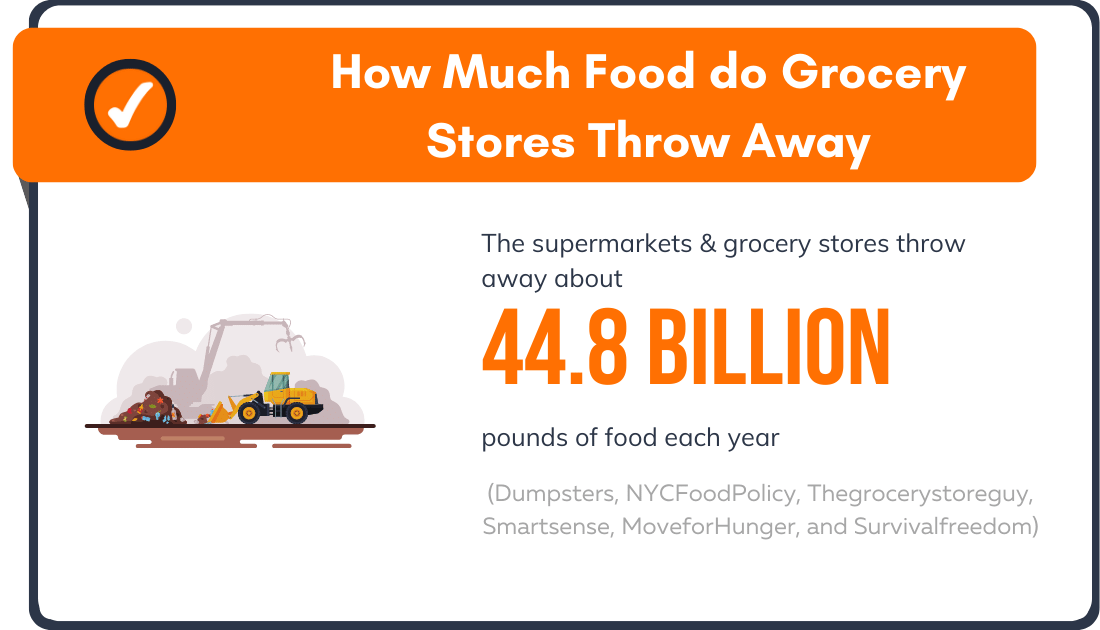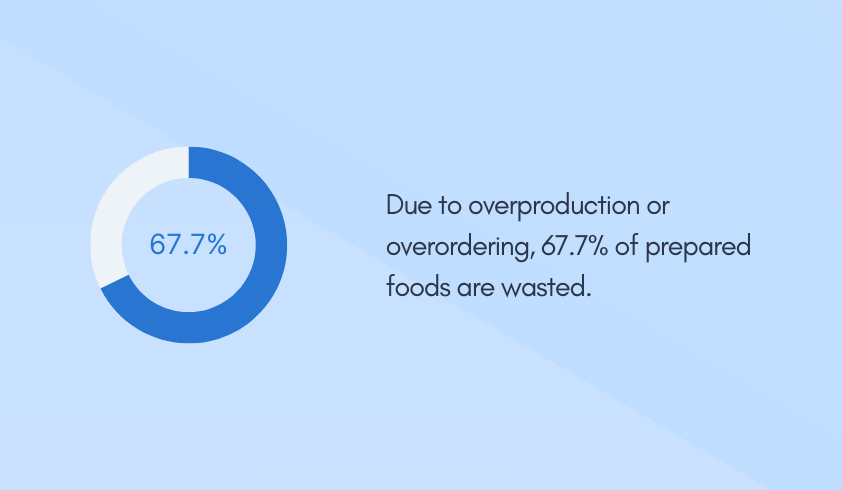Grocery stores in the United States face a substantial issue with food waste, as about 30% of food is wasted, posing both environmental and economic challenges.
This waste translates to a significant financial loss, costing grocery stores an estimated $18.2 billion annually.
To emphasize the magnitude and importance of this issue, let me share the most crucial grocery store food waste statistics you should be aware of right away. 🌽🗑️
Retail Food Waste Statistics: The Key Data
- About 30% of food is wasted by grocery stores in the United States.
- Approximately 16 billion pounds of food waste are generated annually by US retail stores.
- Food waste costs grocery stores an estimated $18.2 billion annually.
- Food waste in the retail sector is valued at roughly 2X the amount of profit generated from food sales.
- 40% of total food waste is generated at the retail level, which includes grocery stores, restaurants, and food service companies.
- The average American grocer throws away $5,000–$10,000 worth of food per week.
- The majority of this waste came from produce (32.3%), dairy and eggs (13.9%), and fresh meat and seafood (13.5%).
- In 2021, retailers produced 5.12 million tons of excess food, nearly 35% of which was disposed of in landfills or incinerated as waste.
- Due to overproduction or overordering, 67.7% of prepared foods are wasted.
- In the United States, the market share of conventional supermarkets has decreased from 69.7% in 2017 to 66.2% in 2022.
Sources: (RTS, Waste 360, Refed, Forbes, Food Engineering Mag, Winsight Grocery Business.)
How Much Food do Grocery Stores Throw Away
The supermarket & grocery stores throw away about 44.8 billion pounds of food each year according to the data we gather from Dumpsters, NYCFoodPolicy, Thegrocerystoreguy, Smartsense, MoveforHunger, and Survivalfreedom. This number includes spoiled food, expired, or simply not sold.

Some of this food is donated to charities or used to feed animals in zoos and sanctuaries, but a large portion is simply thrown away.
There are several ways to reduce the amount of food that grocery stores discard each year.
First, consumers can be more mindful of what they buy and make sure not to purchase too much food. Second, grocery stores can develop better systems for tracking and selling leftover food products.
How much food do grocery stores throw away each day
On average, grocery stores discard 122.7 million pounds of food each day.

This food comes from a variety of sources: expired products, items that are damaged or have gone bad, and items that are close to their expiration date.
How much money do grocery stores lose from food waste?
Grocery Stores lose an estimated $18.2 billion a year from food waste, according to a report from Refed. That’s about 0.3 percent of all food sales in the U.S.

Wasted food is more than just a financial drain on grocery stores – it has major environmental consequences as well. About 40 percent of food in the United States goes uneaten, while at the same time, 1 in 8 Americans struggles to put enough food on the table.
What percentage of food do grocery stores throw away
It’s estimated that about 10% of the food grocery stores throw away according to a report from Business Insider.
This happens for a variety of reasons, such as being slightly past the expiration date or being misshapen. However, most grocery stores are reluctant to donate this food to charity because of liability concerns.
How much meat do grocery stores throw away
It’s estimated that grocery stores discard around 20% of the meat they receive. This is because the meat is perishable and can only stay fresh for a certain amount of time. When it reaches its expiration date, the store has to either sell it at a discount or discard it.
This waste could be reduced if grocery stores were better able to forecast demand and order the right amount of meat.
Yet, this is sometimes difficult to do because meat demand varies from week to week and season to season. As a result, the store would sometimes over-order and sometimes under-order, resulting in waste.
What percent of food waste goes to landfills
Food waste accounts for approximately 21.5% of all landfill garbage according to the report data we collected from EPA, FDA, NPR, Nycfoodpolicy, Rubicon, and Calrecycle.
This means that more than one-fifth of the stuff we throw away ends up in landfills where it decomposes and emits methane, a greenhouse gas that contributes to climate change.
U.S. Grocery Stores Discard 30% of Food Stock.
Important takeaway:
| Insight from Data | Rationale |
| Significant food wastage in U.S. stores | Nearly one-third of food is discarded by grocery stores, indicating inefficiencies in storage, distribution, or purchase planning. |
| Potential for improving food security | If even half of the wasted food can be redirected, it can substantially alleviate hunger and improve food security in various communities. |
| Sustainability concerns in food sector | Such a high percentage of food wastage implies a considerable environmental footprint in terms of wasted resources used in production, distribution, and disposal. |
Source: Rts
Staggering 16 Billion Pounds: Annual Food Waste of U.S. Retailers.
Important takeaway:
| Insight from Data | Rationale |
| Significant food waste at retail level | The figure of 16 billion pounds annually indicates that retail stores contribute heavily to the overall food waste issue in the US. This does not even include waste at the production, transportation, and consumer levels. |
| Potential for improved sustainability | With such a substantial amount of waste, there is a clear opportunity for retail stores to implement more sustainable practices, reduce waste, and improve their environmental footprint. |
| Urgent need for waste reduction measures | The sheer volume of food waste indicates an urgent need for intervention, whether through policies, technological advancements, or public awareness campaigns, to address this pressing issue. |
Source: Waste 360
Financial Burden: Grocery Stores Lose $18.2B to Food Waste Yearly.
Important takeaway:
| Insight from Data | Rationale |
| Significant financial burden on stores | $18.2 billion is a substantial annual cost, indicating the economic gravity of food waste for grocery retailers. |
| Need for efficient inventory management | High costs imply there may be opportunities to save by improving inventory forecasting and reducing overstock. |
| Potential for sustainability initiatives | Reducing this waste not only saves money but aligns with broader environmental and sustainability goals. |
Source: Refed
Retail Food Waste Valued at Twice the Profit from Food Sales.
Important takeaway:
| Insight from Data | Rationale |
| Food waste eclipses profit margins | The value of food waste being double the profit suggests a significant imbalance and inefficiency in the retail sector. |
| Urgency for waste-reduction strategies | To bolster profit margins, retailers should prioritize and implement effective waste-reduction initiatives. |
| Retailers’ sustainability affects financial health | The direct tie between waste and profit underscores the economic importance of sustainability in retail operations. |
Source: Rts
At Retail Level: 40% of U.S. Total Food Waste Occurs.
Important takeaway:
| Insight from Data | Rationale |
| Retail is a major contributor to food waste | With 40% of total food waste stemming from the retail level, this segment has a significant role in the overarching food waste challenge. |
| Diverse retail establishments need targeted solutions | The inclusion of grocery stores, restaurants, and food service companies suggests that one-size-fits-all solutions may not suffice. |
| Potential for large-scale impact through retail reforms | Addressing waste in this sector could lead to significant reductions in the overall food waste footprint. |
Source: Rts
American Grocers Toss Between $5K-$10K Worth of Food Weekly.
Important takeaway:
| Insight from Data | Rationale |
| Significant weekly financial losses for grocers | The range of $5,000–$10,000 weekly highlights the acute economic impact of food wastage on individual grocers. |
| Imperative for waste reduction measures | The consistent monetary loss emphasizes the need for effective strategies to curtail wastage and bolster profitability. |
| Opportunity for reinvestment in sustainable practices | Savings from reducing waste can be channeled into sustainable and innovative practices, amplifying overall store efficiency. |
Source: Forbes
Top Culprits: Produce (32.3%), Dairy/Eggs (13.9%), Meat/Seafood (13.5%).
Important takeaway:
| Insight from Data | Rationale |
| Produce leads in grocery waste | At 32.3%, produce represents the largest category of food waste, pointing to potential challenges in freshness preservation or overstocking. |
| Dairy, eggs, meat, and seafood combine for significant waste | Together, these categories (27.4%) suggest perishables have a higher susceptibility to waste, underscoring the importance of efficient inventory and storage solutions. |
| Emphasis on preserving fresh items is paramount | The high wastage in fresh categories indicates a need for strategies specifically targeting the preservation and sale of fresh foods. |
Source: Refed
2021 Retail Excess: 5.12M Tons of Food, 35% Dumped or Burned.
Important takeaway:
| Insight from Data | Rationale |
| Retailers generated a substantial volume of excess food | The figure of 5.12 million tons signifies a pressing need for better inventory management and production controls. |
| A significant portion directly impacts the environment | With 35% ending up in landfills or incinerated, this waste directly contributes to environmental degradation and greenhouse gas emissions. |
| Opportunity for sustainable waste management exists | The data points to a gap in waste management, emphasizing a potential area for improvement and more eco-friendly solutions. |
Source: Refed
Overproduction and Overordering Account for 67.7% Prepared Food Waste.

Important takeaway:
| Insight from Data | Rationale |
| Overproduction and overordering are primary culprits | The staggering 67.7% wastage rate underscores the acute inefficiencies in forecasting demand for prepared foods. |
| Urgent need for improved demand forecasting | Such a high percentage indicates a significant disconnect between production and actual consumption, suggesting room for improved data-driven forecasting. |
| Opportunity to increase profitability and sustainability | By addressing the core issues, businesses can not only reduce waste but also enhance their economic returns and environmental footprint. |
Source: Food Engineering Mag
Traditional U.S. Supermarkets Decline: 69.7% Market Share in 2017 to 66.2% in 2022.
Important takeaway:
| Insight from Data | Rationale |
| Conventional supermarkets are losing dominance | The decline from 69.7% to 66.2% indicates a noticeable shift away from conventional supermarkets over a five-year span. |
| Consumers are potentially diversifying shopping venues | The decreasing market share might reflect a broader change in consumer shopping habits, possibly towards specialty, online, or smaller-format stores. |
| Adaptation and innovation is crucial for supermarkets | To remain competitive, conventional supermarkets need to identify and adapt to the emerging trends and preferences that are driving this market shift. |
Source: Winsight Grocery Business